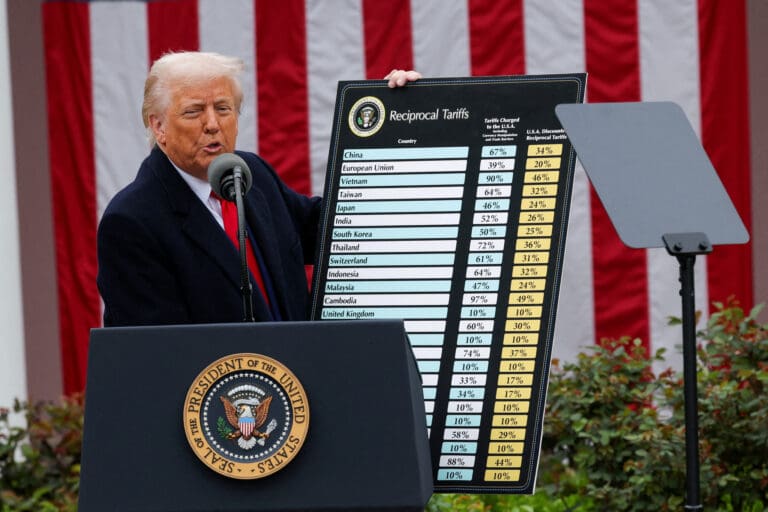Crypto News: Marktupdate April 2025
In April 2025, the U.S. economy was marked by conflicting signals: while job growth exceeded expectations and the labor market remained strong, uncertainty surrounding former President Trump’s import tariffs created tension. These trade measures, combined with fluctuating inflation figures and the Federal Reserve’s policy responses, kept both businesses and markets on edge. At the same time, Trump’s decision to temporarily pause many of the tariffs offered hope for improved trade negotiations, but also prolonged uncertainty.
April 4: U.S. Job Growth Rises in March, But Unemployment Also Increases
In March 2025, the U.S. added 228,000 jobs — significantly more than the expected 140,000 and an improvement over February, which was revised up to 117,000. The healthcare sector contributed notably, adding 54,000 new jobs, in line with its average growth over the past year. Average hourly earnings rose by 0.3% compared to the previous month, translating to an annual increase of 3.8% — the lowest rate since July 2024.
Despite the strong job growth, the unemployment rate edged up slightly to 4.2%, partly due to higher labor force participation. The figures come amid growing uncertainty sparked by the import tariffs recently announced by former President Trump. These trade measures have heightened fears of a global trade war, potentially dampening economic growth prospects and making companies more cautious about hiring new workers. (Source: CNBC)
April 4: Fed Chair Powell Warns: Trump’s Tariffs Raise Inflation and Slow Growth
Fed Chair Jerome Powell warned that Trump’s new, higher tariffs are likely to cause higher inflation and slower economic growth. The Fed is closely monitoring the situation and is waiting for more data before adjusting its interest rate policy.
Although the tariffs will likely temporarily push inflation higher, the effects could also be lasting, increasing the risk of entrenched inflation expectations. Powell emphasized that it is the Fed’s responsibility to keep these expectations under control.
Despite strong employment figures, soft economic signals point to a possible slowdown. Stock markets fell sharply due to concerns about a trade war and retaliatory measures from countries like China. Powell indicated that the Fed will not cut interest rates for the time being but is waiting for clarity on the economic impact of trade policy. (Source: Reuters)
April 9: Trump Announces 90-day Pause on Many Tariffs, Increases China Tariffs
President Trump has imposed a 90-day pause on the ‘reciprocal’ tariffs he recently applied to 57 trading countries, including the EU, Japan, and South Korea. During this period, a general 10% tariff applies to many imported goods from these countries. This pause is intended to create room for negotiations on lowering trade barriers.
At the same time, Trump drastically increased tariffs on Chinese goods to 125%, in response to Chinese countermeasures. Tariffs on steel, aluminum, and automobiles remain unchanged, as do the fentanyl-related duties on goods from Canada and Mexico, provided they do not comply with the USMCA trade agreement.
Sommige sectoren zoals koper, farmaceutica en kritieke mineralen blijven voorlopig vrijgesteld van tarieven, maar kunnen in de toekomst alsnog aan onderzoek en heffingen worden onderworpen. Deze stap volgt op een week van marktvolatiliteit en zorgt voor onzekerheid over Trumps handelsbeleid. (Bron: Reuters)
April 10: Inflation Drops to 2.4% in March, Core Inflation Hits Lowest Level in 4 Years
U.S. inflation dropped to 2.4% in March, lower than expected, mainly due to falling energy prices. Core inflation, excluding food and energy, stood at 2.8%, the lowest since March 2021. Food prices rose, particularly for eggs. These figures come after Trump’s decision to temporarily pause some tariffs and initiate a 90-day negotiation period. Economists warn that the Fed will need to balance rising prices caused by tariffs against a slowing economy. Rate cuts are not expected until June. (Source: CNBC)
April 11: Moderate Increase in Producer Prices in March Eases Inflation Concerns
In March, U.S. producer prices rose by 0.2%, mainly due to higher service prices, while goods prices fell by 0.1%. This eased concerns about accelerating inflation. Costs for services such as securities trading and portfolio management increased, while hotel prices declined. Cheaper oil and eggs contributed to the decrease in goods prices, although prices for poultry and electric power rose.
Despite the moderate price increase, the labor market remains strong, with declining unemployment claims and a steady low unemployment rate of 3.8%. Economists expect the Fed to remain cautious with interest rate cuts, given the balance between inflation and a tight labor market. (Source: Reuters)
April 30: U.S. Economy Shrinks in First Quarter Due to Uncertainty from Trump’s Policies
The U.S. economy contracted by 0.3% in the first quarter of 2025, mainly due to a sharp surge in imports just before the implementation of Trump’s new tariffs. Imports increased by 41.3%, which weighed on growth since imports are subtracted from GDP. Consumer spending was lower than in the previous quarter but still positive (+1.8%). Meanwhile, investments in domestic equipment rose significantly (+22.5%), possibly also driven by tariffs. Government spending declined by 5.1%.
The introduction of 10% tariffs on foreign trade partners and the subsequent temporary suspension created uncertainty among businesses. This could positively impact GDP in the coming quarters if the import surge diminishes.
Inflation rose by 3.6% during the quarter, complicating the Federal Reserve’s consideration of interest rate cuts. However, the labor market remains relatively strong with modest job creation.
The report reveals a fragile economy with a risk of recession, while Trump is attempting to turn the economic tide through negotiations with trade partners. (Source: CNBC)
Conclusion
The developments in the first quarter of 2025 illustrate a fragile U.S. economy balancing between growth and risks. Although the labor market remains solid and some indicators are positive, import surges and trade conflicts weigh on growth and increase inflationary pressures. The Fed faces the challenge of implementing appropriate monetary policy amid these conflicting signals, while the outcome of Trump’s trade negotiations remains crucial for economic recovery and long-term stability.



